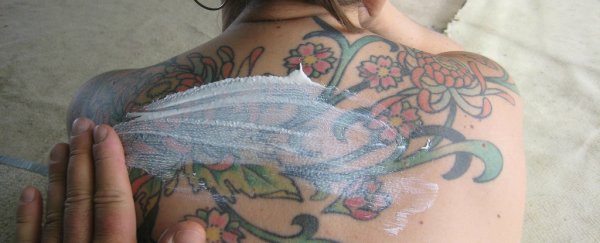Over the past few years, concerns have been raised about the safety of modern sunscreens. The problem is that when we slather ourselves in them to avoid getting burnt, the chemicals are able to penetrate our skin and even enter our blood stream, where research suggests that they can interfere with our hormones and potentially cause cellular damage.
But researchers at Yale University in the US have used nanoparticles to develop a new type of sunscreen that can't penetrate the skin, effectively overcoming lot of the health concerns associated with chemical sunscreens. Even better, it's clear and water resistant, and in animal models it's been shown to be just as effective as protecting against sun damage.
"We found that when we apply the sunblock to the skin, it doesn't come off, and more importantly, it doesn't penetrate any further into the skin," lead researcher Mark Saltzman said in a press release. "Nanoparticles are large enough to keep from going through the skin's surface, and our nanoparticles are so adhesive that they don't even go into hair follicles, which are relatively open."
The sunscreen works by using nanoparticles that have a rich coating of aldehyde groups, which makes them stick eagerly to the outer layer of our skin. This coating also locks in the active ingredient of the sunscreen, a hydrophobic chemical called padimate O, stopping it from being directly exposed to the skin.
This means that the sunscreen contains a much lower amount of the active ingredient than commercial chemical sunscreens, but experiments in mice showed that it's just as effective as protecting against sunburn. It also stayed on the skin for days, even after being exposed to water, but came off completely when rubbed with a towel.
To test whether the ingredients were penetrating the skin, the researchers applied sticky tape to skin that had been treated in the product, and skin that had been covered in commercial sunscreen. They then quickly ripped the tape off like a Band-Aid over and over again to remove the majority of the outer skin layer.
Tests showed that their nanoparticle sunscreen hadn't penetrated the skin at all, while traditional sunscreen had soaked into that top layer. Previous research has also found traces of chemical sunscreens in breast milk, urine, and bloodstreams.
The team also took things one step further, and showed that this penetration was causing an increase in DNA damage to skin cells. This is because when the active ingredient in sunscreen absorbs UV light, it not only stops sunburn - it also triggers the production of oxygen-carrying molecules called reactive oxygen species, or ROS.
If the active ingredient has already penetrated the skin when that happens, those ROSs can cause cellular damage, and research suggests they may even trigger skin cancer.
"Commercial chemical sunblock is protective against the direct hazards of ultraviolet damage of DNA, but might not be against the indirect ones," said Yale dermatologist Michael Girardi, who was part of the research team. "In fact, the indirect damage was worse when we used the commercial sunblock."
At the moment, if people want to avoid using chemical sunscreens, their best bet is to use hats and clothing to block the sun, or choose thick, white physical sunblocks such as titanium dioxide or zinc oxide-based creams.
This new nanoparticle sunscreen will need further testing on humans before it's able to be released commercially, but in the future, it could offer a better alternative for people looking to protect themselves against sun damage. We're excited to see what happens next.
The research has been published in Nature Materials.
